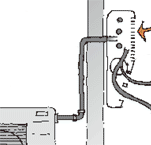Energy
Designing homes to conserve energy and use it efficiently, from sources that cause least environmental harm.
Cooling
In most New Zealand homes, passive design solutions should be sufficient for cooling.
On this page:
- Fans
- Heat pumps
- Evaporative coolers
- Mechanical ventilation systems
Cooling and ventilation should not be confused. Cooling is modifying temperature, which may or may not involve bringing fresh air into a house from outside. Ventilation is about bringing in fresh air from outside or expelling stale air to the outside.
In New Zealand, sufficient cooling can usually be achieved with passive design options such as shading and allowing natural summer airflows and ventilation, given that indoor air temperature comfort levels range from about 18–24ºC and outdoor air temperatures do not often exceed 25ºC. Simulation software can help work out the optimal passive design options.
But some situations may still require active cooling, to provide back-up or boost a passive system when temperatures and/or humidity are well above average.
Active cooling also takes care of situations where building occupants do not open windows.
Active cooling is more likely to be required in rooms:
- with high solar heat gain or poor natural ventilation
- that are used by a lot of people, or used for long periods
- where people are very active (such as a rumpus room)
- with lots of electrical equipment (such as lights and computers in a study)
- in locations where weather conditions do not allow passive design to work effectively, e.g. strong hot or dry winds, dust, pollen
- in calm, hot and humid summer climates.
When specifying a cooling system, consider:
- What is the real requirement? If the demand is only for a dozen or so days each year, portable electric fans may be sufficient.
- How many spaces require cooling? Is it sufficient to cool just one space, such as a north or west-facing living area?
- What would be the most cost-effective option? A ceiling fan may be sufficient if there is just one room where the occupants feel too hot.
Mechanical cooling options are fans, heat pumps, evaporative coolers and mechanical ventilation.
Fans
Fans move air and increase air velocity within a room. They don’t actually change the air temperature, but the increase in air movement makes people feel cooler. Fans should therefore be switched off when rooms are not occupied. Fans can be fixed or portable. They are generally cheap to buy, relatively easy to install, and comparatively cheap to run. This is especially true of ceiling fans – some new models use as little as 4 watts of electricity at their lowest setting and 18 watts at the highest setting. Specify fans with an airflow efficiency of at least 200 m3/hr/W.
While fans can make people feel cooler, their cooling potential is limited to the equivalent of around 3ºC, which is less than that of heat pumps. They can also be useful in winter as they can be used to move the warmer air at ceiling level back down into the occupied space.
Fans have the advantage of providing a cooling effect even when the windows are open – heat pumps cool best when windows are closed.
A study led by the University of Sydney and published in 2022 found that using indoor fans more often allows people to reduce their air conditioner use without changing how hot they feel. This can mean both reduced energy use and reduced greenhouse gas emissions.
“By using indoor fans, the indoor temperature threshold before it becomes uncomfortable for humans (and the main reason why we reach for the air conditioner remote during hot weather) can increase by 3 to 4 ˚C more than air conditioners use alone,” the study reported. The key, as described above, lies in the way electric fans generate higher air speeds across the skin surface to achieve a higher heat loss (and comfort level) despite warmer temperatures.
Heat pumps
Until recently in New Zealand, reverse cycle heat pumps have tended to be installed primarily to provide heating. However, people with heat pumps are increasingly using them for summer cooling as well as winter heating, resulting in increased electricity costs to households that have traditionally not used active cooling systems.
Their efficiency is measured by the energy efficiency ratio (EER), which is the ratio of cooling energy compared to the electricity used to produce it. A heat pump with a higher EER tends to provide more cooling for a particular amount of input electricity. However, the actual energy used will depend on the particular heat pump, how it is used, and conditions such as the outdoor temperature.
Heat pumps for sale in New Zealand must meet the minimum energy performance standard (MEPS) in AS/NZS 3823.2:2013 Performance of electrical appliances – Air conditioners and heat pumps – Part 2: Energy labelling and minimum energy performance standards (MEPS) requirements.
Zoned energy rating labels on heat pumps give a star rating (out of a possible 10 stars) for the cooling performance of a heat pump. The more blue stars, the more efficient a heat pump will be at cooling when compared to other models of the same size. Another great tool for comparing different models is the Efficient Appliance Calculator on the GenLess website.
Heat pumps used for cooling work better when doors and windows are closed (as heating works best, too). Specifying the right size of unit is important.
It is important to note (and to advise your clients) that heat pump energy efficiency decreases as the difference between the indoor and outdoor temperature increases – as it gets hotter outside, it takes more time and electricity to cool the air inside the home.
Evaporative coolers
An evaporative cooler uses a fan to move hot, dry air /adds moisture to the air, and the air temperature drops as warmth is used to evaporate the moisture. Evaporative coolers are only efficient in air that is consistently dry. They are not commonly used in New Zealand and should not be used in rooms that already have moisture problems.
Evaporative coolers:
- are comparatively cheap to run as the only energy used is to run the fan, and this may be as little as 70–100 W, or 150 W and up for larger models. This is a lot less power than a heat pump uses
- are relatively inexpensive to buy. They are available as portable units with a water tank that needs occasional topping-up or as fixed units connected to a water supply
- use a significant amount of cold water
- do not use a refrigerant
- require regular filter maintenance
- may require windows or vents to be left open to allow airflow.
Mechanical ventilation systems
Mechanical ventilation systems are rarely required to meet Building Code requirements – in most cases these are met by opening windows. However, ventilation supply systems can provide cooling benefits. The air intake, usually in the soffit under the eaves, should be located where it will not draw in polluted air. A fan, air filter to remove particulates, ductwork and room diffusers make up a ventilation system.
Heat recovery ventilation systems that use a heat exchange unit are primarily installed to warm the outside air they bring into a house, but some models also provide a cooling option.
More information
- www.smarterhomes.org.nz – cooling
- www.genless.govt.nz – cooling your home
Updated: 11 April 2022


